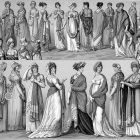Witches in Literature, or Bodies as Translators of Fear

Compared to warlocks, who don’t appear in literature nearly as often as witches, women spell casters are most often associated with representations of fear. The Weird Sisters in Macbeth predict unsettling omens about the instability of his power, the Grand High Witch from The Witches eats children, and three friends from The Witches of Eastwick acquire magical powers after becoming divorcees. There is hardly a witch in literature, save perhaps Glinda the Good Witch, who exists outside of fear.
Primarily, these lady sorceresses are vessels of fear through their bodies – that is, representations used to translate terror. A witch’s greatest strength is her body, as when Circe seduces and distract Odysseus from his journey; it is her greatest weakness, too, as when the Wicked Witch of the West is destroyed: doused in water, her body disintegrates.
The Shining
In some adaptations of The Shining, Jack Torrance enters a hotel room to investigate a poltergeist his son claims to have met. Instead, he walks in on a beautiful young woman soaking in a bath. She steps out of the tub, kisses Jack, then melts into a rotting free corpse under his lips. One might argue this transformation represents that of a witch – a seductress who appears beautiful only to reveal her green skin underneath when her prey is caught or a quest completed. Again, her great beauty here is translated as power – she is the most powerful and feared poltergeist in the hotel.
The Witches
If makeup, or a mask, is considered a translation of the face, then the witches in this children’s story are fluent in both inciting and controlling fear. Most famously, the Grand High Witch is known for her beauty – when she takes off her human face mask, which only happens in front of other witches, the shock of it allows her to command power. She is most terrifying when she is allowed to exist outside of her beauty, and therefore one would imagine outside of the male gaze.
Macbeth
Witches often appear in sisterhood, most notably the Weird Sisters in Macbeth. Shakespeare’s witches are differentiated by “regular” humans not only in their appearance (they’re followed by dark clouds of rain), but in speech – instead of blank verse, their dialogue is always written in rhyming couplets. As prophets for Macbeth, they are translators of the future who make predictions of his power – these predictions, or omens, are what instill fear in him and the consequences of his future.
The Wonderful Wizard of Oz
While the Wicked Witch of the East and West were sisters in the film adaptation of The Wonderful Wizard of Oz, the original book cites both witches simply as a team who seek to conquer the Land of Oz. This seems like a pretty reasonable plan considering their competition as ruler of the land, the Wizard of Oz, is actually just a conman from Nebraska with questionable abilities to govern (see current election cycle).



